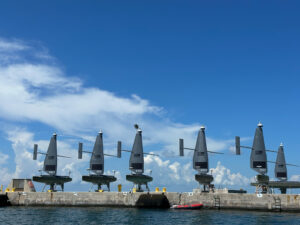Defense Daily
-
 Budget
BudgetHouse Armed Services Committee Wants UAS Office Reporting To Deputy Defense Secretary
The House Armed Services Committee’s (HASC) proposed policy bill would direct the Joint Counter-small Unmanned Aircraft System Office (JCO) to report to the deputy secretary of defense while keeping the […]
-
 Space
SpaceHASC Bill Would Make TacSRT a ‘Program of Record’
The House Armed Services Committee’s (HASC) fiscal 2026 defense bill would require the Chairman of the Joint Chiefs of Staff to establish a Title 10 requirement for the tactical, surveillance, […]
Tagged in: -
 Air Force
Air ForceAccelerate HACM Production Ramp, HASC Advises USAF
The U.S. Air Force plan to field a limited number of RTX [RTX] Hypersonic Attack Cruise Missiles (HACM) by 2028 has led to a stated concern by the House Armed […]
Tagged in: -
 Navy/USMC
Navy/USMCNavy Used BALTOPS Exercise To Demonstrate USV Tactics, Evaluating Vessels
The head of a Navy task force focused on evaluating and using lower cost unmanned systems for 6th Fleet said recent testing at the Baltic Operations 2025 (BALTOPS) maritime exercise […]
Tagged in: -
Tuesday, July 15, 2025
- HASC Backs Army’s ATI Plans, While NDAA Draft Directs More Details On Proposed Cuts
- Saronic, Vigor Marine Partner Around Support For Autonomous Vessels At Scale
- Trump: NATO To Purchase ‘Billions’ In U.S. Weapons For Ukraine, Including Patriots
- HASC Releases NDAA Text With Nuclear Energy Working Group, Two-Site Pits
- DoD AI Office Awards Frontier AI Contracts For Workflow Needs
- Saildrone Envisions European Expansion After Baltic Sea Exercises
- BREAKING: Noem Terminates Eastern Shipbuilding’s Work For Third And Fourth OPCs
-
Tuesday, July 15, 2025
- HASC Backs Army’s ATI Plans, While NDAA Draft Directs More Details On Proposed Cuts
- Saronic, Vigor Marine Partner Around Support For Autonomous Vessels At Scale
- HASC Releases NDAA Text With Nuclear Energy Working Group, Two-Site Pits
- DoD AI Office Awards Frontier AI Contracts For Workflow Needs
- Saildrone Envisions European Expansion After Baltic Sea Exercises
- Trump: NATO To Purchase ‘Billions’ In U.S. Weapons For Ukraine, Including Patriots
- BREAKING: Noem Terminates Eastern Shipbuilding’s Work For Third And Fourth OPCs
-
 Congress
CongressHASC Backs Army’s ATI Plans, While NDAA Draft Directs More Details On Proposed Cuts
While the House Armed Services Committee’s defense policy bill draft backs most of the Army’s divestments as part of its new transformation plan, the legislation directs the service to provide […]
-
 Advanced / Transformational Technology
Advanced / Transformational TechnologySaronic, Vigor Marine Partner Around Support For Autonomous Vessels At Scale
Startup autonomous surface vessel developer Saronic Technologies and legacy industrial ship repair and small vessel builder Vigor Marine Group have partnered to leverage their respective capabilities to increase support for […]
-
 International
InternationalTrump: NATO To Purchase ‘Billions’ In U.S. Weapons For Ukraine, Including Patriots
President Trump on Monday announced a new plan for NATO countries to purchase “billions of dollars” in U.S. military equipment that will be provided to assist Ukraine, including Patriot air […]
-
 Unmanned Systems
Unmanned SystemsSaildrone Envisions European Expansion After Baltic Sea Exercises
The founder and CEO of unmanned surface vessel (USV) company Saildrone said the company is ripe for significant expansion to more European customers following a June NATO test and demonstration […]
Tagged in:

